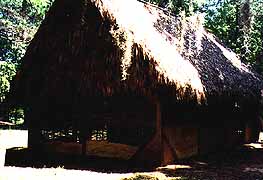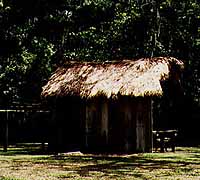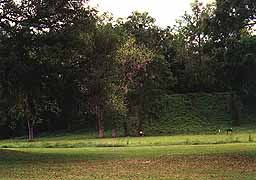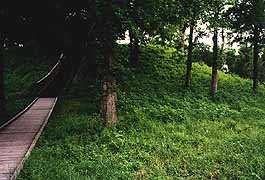American Sabbatical 84: 4/3/97
Emerald Coast
4/3.. Emerald Coast.
It was a Tallahassee morning, and we needed to stock up on a couple of items before we rolled
overhill. Art supplies. I was down to last pages in yet another
watercolor notebook, so we scoped out that scene. Not a hot spot
for artists, apparently, but we did find one outlet, with the
usual art students behind the counter.
You can count on art supply stores to be deviant-friendly environments.
These kids were a bit spooky, though. When they heard what we
were up to they said, “Wow, just like Easy Rider, huh? You’re
like old hippies, huh?” Not the image I’d have chosen to start
the day with.
Actually I’d started the day with a black e-poem about a car crash,
from an old buddy in Indiana. Now I’m not superstitious. Well,
actually, I am. Synchronicity is a star I steer by. So I’m doing
warding rituals and thinking hyper-caution today.
In that mood we negotiate the bland burbs of Tallahassee looking
for the site of a Spanish mission (1600s), and miss the turn three
times. I’m not nervous. Then we climb up into a grove of live
oaks and chestnuts, filtering the sunlight with their new leaves,
and lifting our spirits with their crooked reachings and striving
canopies. I rub my back against an old venerable to do a sketch
while Peggy does the tour. Gabbling hoards of 4th graders school
past, animating the dappled grove.
(Memo #76)
April 3 Apalachee Mission San Luis
Who? Florida First People & Spanish missionaries
What? mission and Apalachee village site
Where? Tallahassee, Florida
When? 1656-1704 A.D.
How? Apalachee request missionaries, Spanish build a chain of
missions
Topics: Florida mission, Apalachee tribe, culture contact
Questions: Why did the Spanish establish a mission at San Luis?
What was life like at the mission? How did the Spanish and Apalachee
get along? |

Mission St. Luis
|
At Santa Barbara, California, we saw one of the missions established
by Father Junipero Serra. Most of his string of mission communities
up the coast of California still exist and the buildings are popular
tourist attraction. Far less known is the string of missions established
by Spanish missionaries from St. Augustine north along the coast
and to western Florida. Or the “praying towns” for Christianized
Native Americans established by the Puritans in a circle around
Boston (about where Route 495 is today). None of these has existing
buildings, only archaeological artifacts.
Mission San Luis was located on a hill in western Tallahassee,
a ten minute drive from Florida State University. Today the hill
site has a large 1920’s mansion house and outbuildings and huge
wild oak and magnolia trees on it. It has been a working archaeological
site since 1983 and there are covered excavation trenches all
over. Archaeologists are greatly helped in their work on San Luis
by the Spanish documents and maps which describe the mission and
events there. There is a walking tour with bulletin boards spaced
along it. A Spanish colonial dwelling and an Apalachee house have
been reconstructed. The village’s large central plaza is outlined
by a circular roadway. The large palisaded and moated Spanish
fort is outlined in white stones as are the Catholic church and
the Apalachee council house.
DeSoto was in the area in the 1500’s and saw the agricultural
Appalachee village of Anhika nearby. The Apalachee were one of
many North American tribes to welcome Europeans. The group requested
missionaries. Archaeologists suggest that the Apalachee wanted
Spanish goods and that the chief may have needed Spanish help
to support his authority. For their part, the Spanish were eager
to get agricultural products from the tribe to provision St. Augustine
and extend their string of missions. Missionaries from St. Augustine
visited in 1608, and in 1633 the first Mission (San Luis de Jinacayca)
was established. However, an uprising in 1647 (much like the Great
Pueblo Revolt later in the century) destroyed churches and killed
the Spanish deputy governor, his family, and three priests. In
1656 a new Mission San Luis (consisting of Spanish church and
large Apalachee village) was established here which became the
center of an active Spanish province (there were 14 missions in
the Tallahassee area) with its own Governor. The mission settlement
had more than 1500 inhabitants (farmers, soldiers, ranchers, craftsmen,
priests) and there was another Apalachee village two miles away.
The Spanish claimed the Apalachee were “thoroughly Christianized”
by the 1670’s. A fort was added in 1690 after the English began
actively colonizing in Charles Town (Charleston).

Colonial House
|
In 1702 Queen Ann’s War began in Europe causing fighting between
the English and Spanish in North America. Both had Native American
(First People) allies. In 1704 a large English and Creek force
invaded La Florida and the Spanish burned and abandoned Mission
San Luis. All that remains VISIBLE today is the plaza (encircled
by a slightly raised band of earth) and part of the fort. After
1704 the Apalachee split into two groups, one group went to St.
Augustine and was later killed. The other headed west. Today the
Apalachee descendants in Louisiana are trying to get governmental
recognition as a tribe. |
Excavations at San Luis have turned up a wealth of artifacts many
of which are displayed for visitors. There are: bits of Spanish
and Apalachee pottery, gun flints, musket balls, rapier blades,
nails, hardware, hinges, window latches, religious items
(a crystal cross, part of the baptismal font), jewelry, even thread.
Cultural contact is shown by glass projectile points and Apalachee
pottery that uses Spanish elements. Artifacts indicate the trade
among North American tribes which sent shells north from Florida
and copper, soapstone, and mica into this area from further north.
Trade within the Spanish empire is shown by artifacts from the
Caribbean and Spain.
| The Mission San Luis buildings are indicated by foundations, wall
remains, and post hole demarcations (the wooden beams rot in place
and leave dark circles in the earth which stand out vividly).
A small rectangular Spanish dwelling (dirt floor, thatched roof,
wattle and daub walls) has been reconstructed near where they
found the foundation. Several round thatched Apalachee houses
and a fence enclosed garden (corn, beans, squash) have been constructed
near the fort. There are plans to reconstruct the large church
and the Apalachee council house. |

Apalatchee Interior
|
San Luis has the remains of the largest council house found so
far in the Southeast. It was 108 feet in diameter, a huge thatch
roofed building supported by massive posts and beams. The roof
came down to near the ground, there were wattle and daub walls
There was a center fire. This building shows the importance of
the site and the influence of the chief. Our guides described
life at the mission as we toured, from meals in the priests’ home
to the beautiful Latin hymns sung by Apalachee converts, from
ball games on the plaza to pottery making in a shard strewn workshop
area they’ve excavated.

Mission St. Luis
The Apalachee of Mission San Luis are only one of the many Florida
tribes which include the Pensacola, Timucua, Tocobago, Ais, Jeaga,
Mayaimo, Calusa, Tequesta, Seminole. First People have been in
the Tallahassee area for centuries.

Lake Jackson Mound
|
After we toured Mission San Luis, we drove several miles to the
Lake Jackson Mounds State Archaeological Site on the shores of
the large lake. It was a large ceremonial center from around 100
ad to 1450 ad, part of what archaeologists call the “Southern
Ceremonial Complex”. Two dirt mounds are visible in the park.
We climbed the larger one, now covered with grass and vines. It
was perhaps sixty feet tall and thirty yards across at the base.
It reminded me of the superb Cahokia ceremonial site in East St.
Louis (with its seventy three earthen mounds dominated by the
great mound which has a fourteen acre base). Lake Jackson is much
smaller scale. Historians and archaeologists muse about reasons
for the earthen pyramids erected by tribal groups throughout the
Southeast and Mississippi Valley. It could be simple longing for
elevation. It was lovely to be on a high hill after days of driving
through the swampy flatlands of Florida! |
4/3.. cont.
As long as we’re going backwards down the tunnel, we point our time machine at the Jackson Lake
Mounds, circa 1000 AD, down JoeBob Drive, or some such. The streets
in these Southern towns seem to require two nominatives: Lucy
Maude Ave., or Edwina Percy St., or.. but you get the idea. Kind
of like boat names Downeast.
The Mounds were a mixed excitement. Three grassy lumps in a shady
grove of chestnuts, one maybe 80 feet tall, and steepsided. The
requisite mounted text made the usual noncommittal statements
about the mound-builders. “We don’t know why they built these
mounds...”
“Because it’s so blessed FLAT around here,” mumbled Peggy. And
the noisy delights of school kids on holiday tripped us up and
made the leaves rattle. So why were the 4th graders being herded
dutifully through descriptions of Spanish colonial posthole pentimenti
and other archeological fascinations on holiday week? Some sort
of booby prize for good behavior? We broke bread and oranges and
ruminated onward.
|

Climbing the Mound
|
West of the capitol, the panhandle can be quite lovely. We struck
west-south-west to avoid the interstate, intending to rejoin the
coast around Panama City. Skirting Lake Talquin and crossing the
Oklochonee River, we passed pairs of men engaged in the native
wand ritual. Floridians are either born with fishing rods in hand,
or the magic implements are pressed into their clutch on baby’s
first new moon by local witch doctors. I don’t think we saw a
single roadside puddle in the state without its resident ritualists,
usually in pairs. A bonding thing perhaps.
The other team sport down here is congregating in His name. JESUS
SUFFERED FOR YOU. Hand painted homily, movable type sign message,
mega-billboard blazoning, bumper sticker attestation, THE WORD
is proclaimed everywhere you turn. When a carful of natives beeps
past, all pumping their fists in solidarity, I assume it’s because
of OUR stern-message: GRACE HAPPENS. At least I think that’s what
they mean. JESUS WEPT.
The sanctified billboards in south Florida invariably show doting
grandparents dandling babes: LIFE IS IMPORTANT AT OUR AGE. Anti-abortion
messages, subtle or otherwise, grace the illuminated signs of
roadside churches across the South. IMPEACH EARL WARREN signs
are long gone, and the stars and bars don’t fly as frequently,
but babykilling is still a hot button below the frostline.
I’m guessing, but I suspect that the evergreen hardwoods.. magnolias,
live oaks and that lot.. only thrive where the frost doesn’t get
into the ground. No mud season, and green holly for Christmas.
But some of them do shed their leaves in the Spring, when new
leaves replace them. So in this time of resurrection and renewal,
bushy balls of that old pagan mistletoe hang dark and dense in
the pale green canopies of the holy oaks. It feels more like Spring
here in North Florida, instead of an endless Summer. The woods
in the western panhandle are losing that sub-tropical frondy-ness,
and are lushening up with deciduous undergrowth.. like kudzu.
That pre-Honda Japanese invasion.
Still cautiously watching the temp gauge and the miles per, we
crest a small rise out where pine woods begin to line the roads
again. The traffic has thinned to an occasional log truck, with
feller-bunched harvests in the bunks and a trail of bark and branch
chunks bouncing behind, and we can see way down a long corridor
to a crossroads with a mom-and-pops gas and grocery. Suddenly
there’s a reflective flash and a puff of smoke, and as the camera
focuses in people are running across the roadway. Two cars are
crumpled together at the intersection.. pump the brakes.. slow
swinging wide of a woman waving us round... and a closeup of the
shock-frozen faces of two elderly women, and the rear ends of
men leaning into the backseat of one car. Plenty of visibility
in all directions. One of those freak accidents, maybe. Hope that
was our crash karma for the day. The locals wave us past, and
we slowly fade into the distance.
The road is all torn up at the Apalachicola, where the river is
bounded by cypress swamps, and a new cement pylon causeway is
under construction. We pass on into Central Time without skipping
a beat. We are now due south of Cincinnati. And into clearcut
country. Pine plantation again, and where it’s been scalped the
white sandy ground looks like a desert. There are pot hole lakes
and ponds every mile or so, but the water-table is way down, and
the cracked and rimed perimeters make me wonder if that’s the
result of drought, or no trees to maintain water-retention?
Now the north-south crossroads are full of highspeed automotion,
and we opt to carry on west a ways on our quiet road, past Panama
City, before heading to the beach. Well.. it doesn’t make any
difference. When we do join the flow, we realize that everyone
in Alabama is hurtling across the panhandle to get at the Gulf-side
delights. It’s still Spring Break, kids. All the partying doesn’t
happen in South Florida.
We strike the Yahoo and Eehaw at Panama City Beach and it’s wall
to wall exposed flesh and beer coolers. Seas of young adults surging
across the beachroad from burger outlets to highrise motels. The
sky is covered in high overcast and there’s half a gale blowing
in off the Gulf, but the cresting emerald waters are solid with
bobbing youth. Looks like a run of capelin hurling themselves
on the beach to spawn. That’s probably in some minds out there,
too.
Laguna Beach. Sunnyside. Hollywood Beach. Another coastal boom
strip. Some hurricane must have scourged this coast in recent
years, because there are whole stretches where the palmettos are
just re-fronding, the scrub woods are all cockeyed, and the houses
are all brand new. Grinning contractors in every drive. All the
ambiance of Topsail Island.
The new construction all shares a certain flavor, similar shapes
and color-schemes, as though by ordinance. The “cottages” tend
to be square in plan and vertical in elevation, as if craning
to get a sea view. Most buildings are capped with little mansard-roofed
cupolas, or top stories, with colored tin (or plastic?) roofs.
These gaudies are sided in faux board and batten. The Taco-Bell
look. Pale lime, taupe, faded salmon, off-yellow, Mediterranean
blue, and Spanish tile orange, are the approved colors. Clustered
in planned angularities around little lagoons and inlets, it’s
all very charming.. and sterile as a burn ward.
The beaches beyond are spectacularly white against that unbelievable
green, with stunted pines holding the dune brows together. PICKING
SEA-OATS PROHIBITED. I wouldn’t know an endangered sea-oat, if
I was served one. I think all those cement seahorses are to blame.
We’d foolishly thought to find a motel room or campsite on a quiet
stretch of sandy interlude. HAH. The Owl driver was getting tired
and short-tempered, and the navigator was muddled and confused.
Words were spoken hastily. Hey, it was a great party. We pulled
into a public access lot to cool off. I go chat up a FedEx driver
who has stopped to use the public, and I hear tires spinning out
the lot. Look, and there’s a little red Festiva, with a blue bumpersticker,
making smoke upcountry. A moment of doubt and pain. Then I see
the Owl, and Peggy, still sitting in the shade. Whoo.
The Owl crew go barefooting in the fine sparkling sand, and soak
our trousers in the surges. The beach actually squeaks underfoot,
utterly unlike the shellfragment beach on Longboat Key. This is
pure silica, and the daytrippers look broiled, even in the overcast.
A skin-eating shore.
Food. We decide. And wheel into a 60’s style diner all in highgloss
aluminum and neon. Goldies on the flip-panel jukes. WWII vintage
Coke ads. Everything absolutely authentic reproduction, down to
the harp-squiggle deco on the fake formica. The prices were contemporary,
and the hush puppies frozen. But we stopped grumbling, and smiled
at the absurdity. We were about the only vintage couple in the
place. Felt like Odysseus returned. A dog in the parking lot even
wagged his tail.
Then we researched the accommodation market in Seaside and Grayton
Beach. Called farther west for Super8 and Motel6 rates and availability.
Nope. Even the down-at-heel joints were full, or outrageous. Fun
time in Holiday City. We made up our minds to push on to the military
environs of Pensacola for a dufflebag special, when we spotted
an EconoLodge just under the causeway bridging the inlet to Choctawatchee
Bay.. and it was cheap. We uncoiled and stretched out flat.





